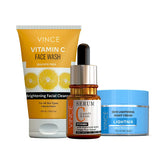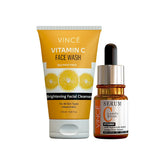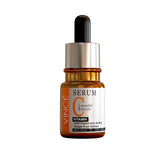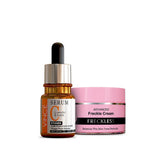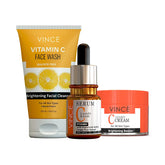Indoor Sunscreen: Why You Need SPF Even Inside Your Home

Done with the basics—cleanser and moisturizer? Check. But sunscreen for home while sitting in your living room enjoying a rare day off may sound unnecessary. However, you need to think again, as SPF for indoor protection is a step you cannot afford to miss.
From factors like blue light skin damage to the relationship shared between UVA rays and windows, Indoor Sunscreen is your best defense for maintaining skin health.
We often overlook digital screen skin damage, but the fact is that UV protection indoors is a must-have and not a maybe. Then comes another challenge of navigating various options ranging from anti-aging sunscreen to broad-spectrum SPF to finalize the best one.
Tuning in to your queries, we have crafted this article to enlighten you about the importance of sunscreen for indoor use and help you spot the best indoor sunscreen that ensures all-day protection.
Sunscreen: Your Daily Essential for Lasting Skin Protection
Enjoying nature with the sun shining on the top is a pleasure that comes with a heavy price, as its damaging rays emit two different types of ultraviolet radiation: UVA and UVB.
Especially if you decide to step outside without lacing your skin with its protective armor - an effective sunscreen, the sun not only brightens your day to its fullest but its harmful rays can:
- Cause sunburn, redness, and DNA damage
- Weaken your skin barrier, making it prone to irritation
- Increase the likelihood of skin cancer
- Trigger pigmentation and accelerate premature aging
- Collagen breakdown, leading to loss of skin elasticity
Looking at their devastating effects, individuals often take caution by wearing sunscreen but tend to overlook the importance of SPF for indoor protection. Read on to learn why dermatologists worldwide recommend indoor sunscreen for comprehensive skin protection around the clock.
Important Link: Discover the Best Sunscreens For Face in UAE 2025
Why Is Indoor Sunscreen Essential?
Following are the primary reasons indoor sunscreen is a must-have accessory you shouldn’t leave out of your skincare essentials:
UVA Rays and Windows: The Unseen Connection
A simple answer to why we need an Indoor Sunscreen is that UVA rays won’t stop at your windows. Most people think that within the walls of their homes, they are protected from a series of skin-compromising issues caused by the sun's UV rays.
However, the sun rays streaming through your windows are letting UVA penetrate inside, making your skin vulnerable to its damaging effects.
Once exposed, the risk of long-term skin issues increases, thus emphasizing the importance of sunscreen for indoor use.

Blue Light Skin Damage
The term “sunscreen” gets its name based on its primary function of screening out or blocking the sun’s damaging rays to prevent any harm to your skin. Hence, individuals automatically treat sunscreen as a skincare essential that guards the skin from the sun.
Let us introduce you to another harmful culprit that rules out the possibility of skipping an indoor sunscreen – blue light from your screens.
Blue light, which also goes by the name HEV (High-Energy Visible) light, is a high-energy light emitted by digital screens, LED lighting, and even the sun. With individuals spending prolonged time on their devices, it has become a serious concern for the skin.
Evidence strongly suggests an association of blue light with inducing oxidative stress and causing skin aging and hyperpigmentation.
While the sun sets at a specified time in the evening, the world’s reliance on devices now calls for wearing sunscreen even during the dark hours of the day.
Important Link: Sunscreen vs Sunblock what’s the Difference
Key Features of the Best Indoor Sunscreen
After establishing the significance of indoor sunscreen, we won’t let you dwell on overwhelming options or feel confused about how to pick the right one.
There are a few properties that make sunscreen comfortable to wear, such as easy absorption and no white sheen. That is exactly why Vince’s sun care range shines above the rest, offering light-weight and non-greasy texture for effortless application and all-day comfort.

Following is a quick checklist that you need to keep in mind to lock the best indoor sunscreen - qualities you will also find in Vince’s premium range:
Broad-Spectrum SPF
Keeping all the silent threats to your skin in mind, including UVA, UVB, and blue light, never settle for a sunscreen that does not offer comprehensive broad-spectrum protection. While UVA rays sneak through the windows and blue light from your screens carries harmful effects on your skin, broad-spectrum acts as an all-in-one defense.
SPF for indoor protection
SPF 30 is the bare minimum for overall skin health, and while UVB rays are not your primary concern indoors, you may still need to step outside briefly.
Additionally, depending on the type of glass in your windows, there is a possibility of some UVA rays passing through. Therefore, always think ahead by taking precautions and choosing an SPF of at least 30.
Tinted Indoor Sunscreen
Tinted sunscreen is a well-rounded choice that comes with the dual advantage of shielding skin against UV rays and blue-light skin damage. Therefore, it takes the preference over regular sunscreen for indoor use.
Apart from being an incredible indoor sunscreen option, these are also comfortable to wear if the white sheen left by traditional sunscreen is a matter of concern for you.
Tinted sunscreen contains pigments like iron oxides in their formulating ingredients that closely resemble natural skin tone. It eventually allows indoor sunscreen to seamlessly blend into the skin without leaving a white, chalky finish.
Important Link: Differentiating Between Physical and Chemical Sunscreen
Sunscreen for Indoor Use: How to Get the Best Results
Once you get your hands on the best indoor sunscreen and stock up on your skin’s daily defender, tap into its full power by following these essential tips and tricks:
Apply Generously
For optimal protection, you need a generous amount of indoor sunscreen, roughly a nickel-sized dollop, evenly covering your face. Also, sunscreen is not an accessory for your face alone but a necessity for all exposed skin, including the neck, ears, and hands.
Indoor Sunscreen Reapplication
Almost all skincare products are mainly recommended for use twice daily except sunscreen, which calls for reapplication.
Sunscreen for indoor use should be reapplied every 4-6 hours for ultimate protection, and frequency increases if you have a habit of touching your face more often.
Also, if you engage in activities that make you sweat, like cooking, exercising, or doing household chores, your sunscreen may wear off faster.
In that case, either reapply after every 2-3 hours or even a better option is to opt for Vince’s water-resistant formula for lasting protection.
Conclusion
Broad-spectrum SPF is broadly acknowledged as an unavoidable essential in our skincare routine; however, UV protection indoors is often overlooked.
The connection between UVA rays and windows and blue light skin damage highlights the need for indoor sunscreen for maintaining long-term skin health and protection.
After spotting the best indoor sunscreen apply it generously on all exposed skin and reapply it every few hours for optimal protection.
Next time, let your sunscreen be your closest companion—even in the comfort of your home.
Frequently Asked Questions (FAQs)
Q1: Is indoor sunscreen really necessary?
Yes, dermatologists recommend wearing indoor sunscreen, especially if you prefer sitting near windows and well-lit areas. The primary cause of skin cancer and aging is the sun’s damaging UVA rays, which can easily penetrate glass windows and harm your skin. Similarly, blue light can trigger melanin overproduction, making indoor sunscreen essential to maintain skin health and an even tone.
Q2: What SPF should I use indoors?
Opt for a broad-spectrum indoor sunscreen with SPF 30 or above. If you tend to engage in activities that make you sweat, like cooking and exercise, prefer a water-resistant formula. You can choose SPF 50 or 75, as they offer marginally better UV protection than SPF 30.
Q3: Does blue light from screens damage the skin?
Blue light from our screens can damage our skin by overproducing melanin, which can lead to dark spots and hyperpigmentation. It also weakens your skin’s overall health, promotes photo-aging, and causes inflammation. To keep your skin in the best shape and avoid blue light damage, apply broad-spectrum Indoor Sunscreen with an SPF of 30 or higher.
Q4: How often should I reapply sunscreen indoors?
Reapplying indoor sunscreen every 4-6 hours is recommended to keep your skin protected from damaging UV rays, especially if you like sitting near the windows or are exposed to blue light from screens. However, if you are involved in activities that tend to cause sweating, like cooking or physical activities, practice reapplying sunscreen every 2-3 hours for comprehensive protection throughout the day.
Q5: Are tinted sunscreens better for indoor use?
Tinted sunscreens provide an extra layer of skin protection by keeping blue light emitted from screens from penetrating deeper and causing premature aging and hyperpigmentation. They contain ingredients, mainly iron oxides, to block blue light, making them an ideal choice for indoor use due to their enhanced, comprehensive protection against skin-damaging UVA, UVB, and HEV light.

 KSA
KSA
